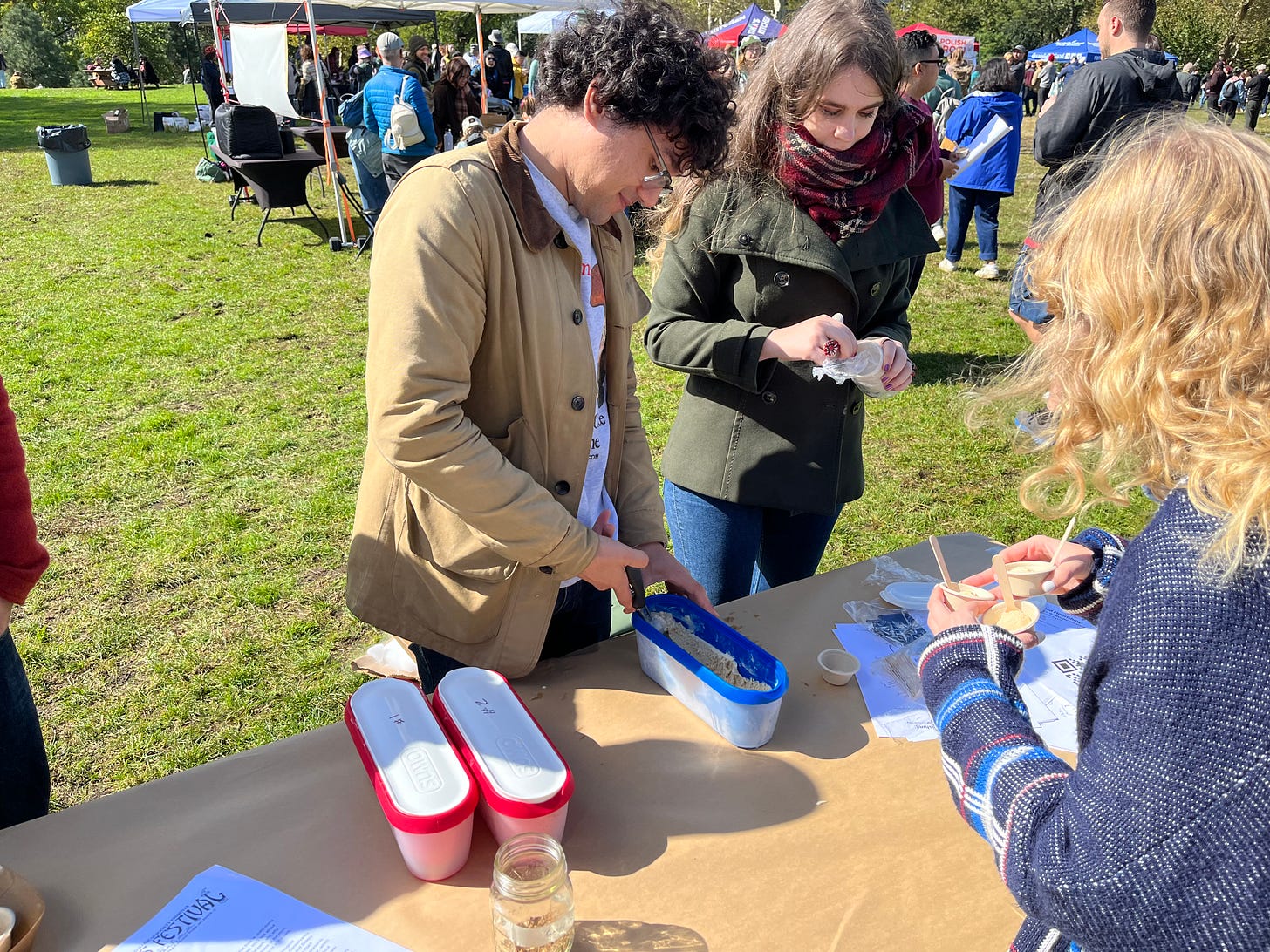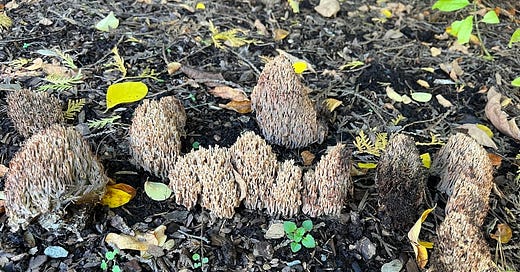Good evening, friends,
I’m riding high off of a very fun and fulfilling Fungus Fest yesterday. Thanks to Sigrid, Sneha, the volunteers, and the rest of the New York Mycological Society for organizing such a wonderful event. It was nice to see a lot of you in real life and I appreciate you coming up to chat. I’ll post some pictures from the event at the end, but that’s after we learn a bit about today’s mushroom in the genus Ramaria. Coral mushrooms, particularly in the genus Ramaria, are not well documented in northeastern North America which makes them very difficult to identify to species, but there’s still good info we can glean from this encounter.

Fun Facts
The shape of this mushroom is an example of one of my favorite ecological phenomenons, convergent evolution. It’s when two organisms that aren’t remotely related develop similar traits/features based on exposure to similar ecological pressures. For example, birds, bats, and insects aren’t remotely related to each other but all developed the ability to fly.
Interestingly, the underwater coral is structured in this way to slow down water currents so the individual polyps can filter feed the nutrients suspended in the water. The leading hypothesis as to why coral mushrooms form their distinct shape is that they want to create as much surface area as possible from which to release spores.

There was a study involving the type species for the genus Ramaria, Ramaria stricta, to identify the presence of “ligninolytic enzymes” in a variety of different fungi (Reference 2). “Ligninolytic enzymes” are digestive compounds in fungi that breakdown lignin, a main structural component of wood and a complex compound that isn’t really broken down by other organisms in nature. These enzymes are desirable because they can potentially be used in a variety of industrial applications (as a natural delignifier of wood pulp in a paper mill or to breakdown the phenols from alcohol and wine production). The study also looked to see if these enzymes were able to breakdown the textile dye Remazol Marine Blue and, while R. stricta wasn’t tested, some other familiar fungi (Turkey Tail, Trametes versicolor) showed promising results.

Some cultures eat Ramaria too, but they’re not traditionally eaten in North America - perhaps because of the inability to distinguish between species. The Forager Chef, Alan Bergo, wrote an informative article on edible Ramaria if you’re curious.
Ecology
In a fun twist, it’s actually unclear whether this fungus is mycorrhizal and forms a symbiosis with trees/plants, or if it’s saprobic and decomposes the dead wood from these trees. This flush was found underneath a row of different shrubs (winterberry and spicebush) where it seemed to weave in and around the base of them. I tried to reach down into the soil to see if there was a dead root down there, but I actually ran into landscaping cloth - this was formerly a mulched, landscape bed. It also seemed like the white mycelium from the fungus was all concentrated in the top inch or two of soil anyway. All this to say that the fungus could be digesting the remnant woodchips, a buried root, or forming a symbiosis with the bushes.

The taxonomy for these species is a mess, but the aforementioned type species Ramaria stricta grows on wood and usually forms longer, upright branches. Even still, it appears that what we know as R. stricta is a complex of several nearly identical species. The other coral I encounter (usually earlier in the summer), the crown-tipped coral (Artomyces pyxidatus), also grows on wood, but isn’t as robust and is a consistent off-white in color. The Ramaria specimen I had was purplish at the base, then off-white at the tips of the branches, and older specimens turned black with age. There’s a lot of research yet to be done on these curious fungi and if I can get my puppies in order I’m going to send a sample in for DNA sequencing as part of the 2023 Fall Mycoblitz - something we can all participate in.
Fungus Fest
I spent most of my time at the main stage so I didn’t get to explore too much, but the day was full of activities like mushroom paper-making, mushroom ale-tasting, a whole set of presentations at the medicinal mushrooms stage, forays, educational booths, vendors, and a whole lot more. The weather cooperated and I had a blast hanging with everyone. See you all next year (but hopefully sooner :) ).


Walks in October
If you got the Friday message, we rescheduled the walk that was supposed to happen past Saturday to the upcoming Saturday 10/21. Now if you’ve looked at the forecast already you’ll see that it is yet again forecasted to rain on Saturday (would make it the sixth in a row). The walk is tentatively still on - 10 AM at the end of Mill Stream Road in Stamford, CT - but that’s very subject to change. I’ll send out another Friday afternoon email if it’s rescheduled.
10/29 in Central Park at 10AM. Meet at the usual spot in the Ramble. I’ll add in the pinpoint location next week but it’s just south of Shakespeare Garden. Costumes are encouraged :)
Email me if you have questions about either walk and have a splendid week,
Aubrey
https://www.mushroommonday.com/
References:
Kuo, M. (2009, May). Ramaria stricta. Retrieved from the MushroomExpert.Com Web site: http://www.mushroomexpert.com/ramaria_stricta.html
Erden E, Ucar MC, Gezer T, Pazarlioglu NK. Screening for ligninolytic enzymes from autochthonous fungi and applications for decolorization of Remazole Marine Blue. Braz J Microbiol. 2009 Apr;40(2):346-53. doi: 10.1590/S1517-838220090002000026. Epub 2009 Jun 1. PMID: 24031371; PMCID: PMC3769734.
http://www.messiah.edu/Oakes/fungi_on_wood/club%20and%20coral/species%20pages/Ramaria%20spp.htm






